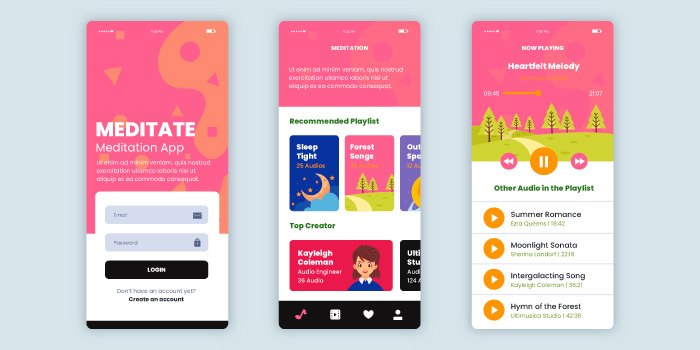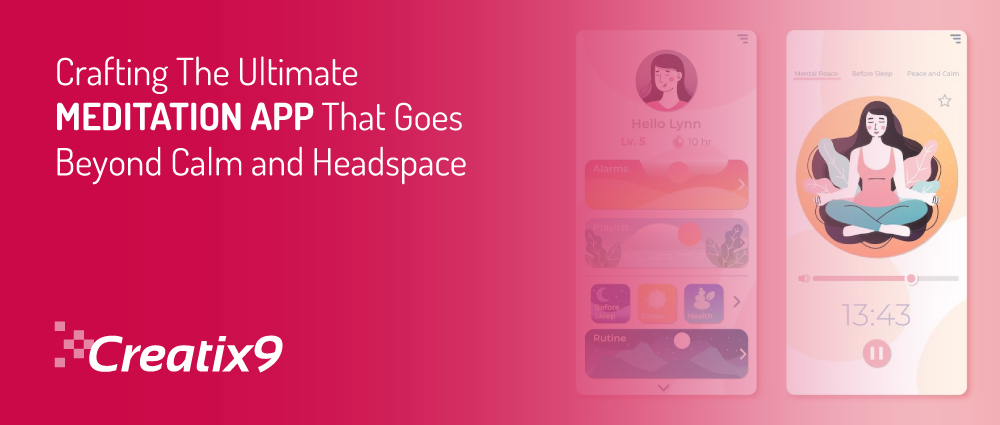
Meditation and mindfulness are the only things that can save us in the modern world. Over the past years, we’ve seen a lot of crises, and it’s been shown that certain habits can help people get through them.
More and more people are making meditation apps for their phones, and the business world can’t ignore this trend. In fact, Statista predicts that these apps will grow by about 13.7% each year from 2023 to 2027. So, the market size will exceed $7 billion by 2027.
You can still join this solid trend train, make money, and improve your clients’ lives.
So, read the blog from Creatix9 US, the top mobile app design and cross-device development company, to learn the best techniques and steps for making a meditation app.
Best Apps For Meditation Techniques: An Overview Of The Market
Like making an exercise or healthcare app, creating a meditation app can benefit your business and the customer if you do it right. Here is a list of the best ways to do things.
Personalized User Experience
66% of customers think that brands should know what they want and expect from things. To do this, you must adjust the user experience. When making a meditation app like Headspace, ensure user information will be given during training. The necessary information includes how long they’ve been meditating, their goals, and what kind of lessons they like best.
Also, consider adding choices for a personalized chatbot, rating meditations, saving favorites, and going over them.
If you follow the best practices in your field, you can make a good meditation app.
eCommerce Features
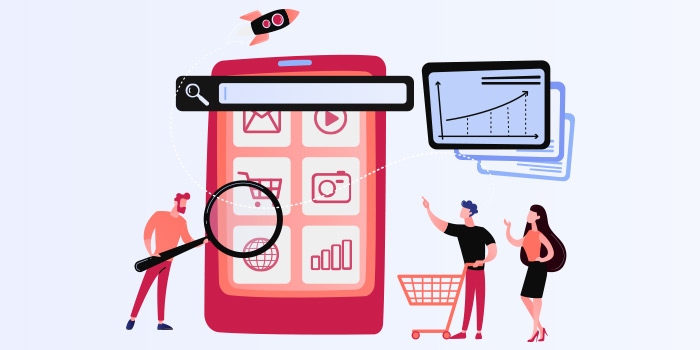
It’s more than just buying paid podcasts and exercises. You can use eCommerce features and sell physical goods to help your customers learn. You can sell bright pillows, weighted blankets, yoga mats, clothes, and accessories. Still, not all businesses that sell meditation apps do this.
Smart Notifications
Users have different plans, time zones, ways they like to meditate, and needs for reminders. Sending out general alerts to everyone might have a different effect than you want and could be annoying. You can improve the user experience by letting people set reminders for the practices that will help them the most and change alerts.
Compatibility With Device and OS
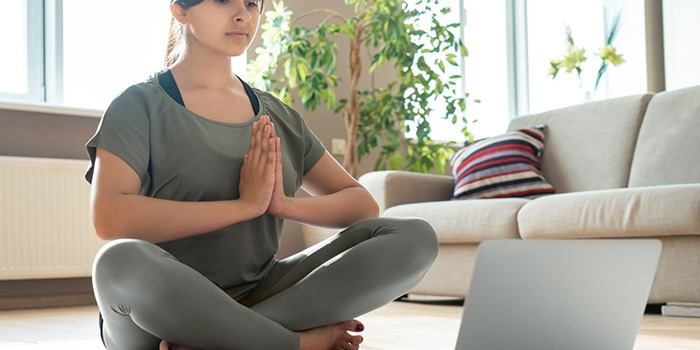
Ensure that your meditation app lets users use it on a wide range of devices, like smartphones, tablets, computers, and even smartwatches so that many people can use it.
Also, make the app easier to use. You can learn how to make a few meditation apps so that your products can also be used on smartwatches.
Chatbot
People will know you care about their thoughts if you use an AI-powered chatbot like the GPT-3 AI chatbot. Users can utilize it to discover the most suitable meditation for them and obtain straightforward responses to inquiries about various topics, including mindfulness and in-app transactions.
The best thing that you can add to such a chatbot is the ability to send a challenging request to a human operator.
Offline Access And Content Delivery
Integrate different content into your meditation app to make it more appealing. Some people find guided movements good for calming down and balancing their chakras, while others like the sound of singing bowls. Combining these parts gives users with different tastes a more exciting and inclusive experience.
Some people like to meditate while moving, so videos of easy yoga poses could be helpful for them. Themed exercises for focusing in the morning, unwinding in the evening, being grateful, etc., will also find an audience. Mix and match these to make a nice meal.
You can also let users save their favorite guided exercises or other activities in a cache when not connected to the internet. Think about how much more helpful it is to download their music, like with Spotify or Apple Music.
Of course, the tools you add to your meditation app will also affect how well it works. A simple success tracker can make your program more personal and keep more people signed up.
Discover the Key Features of Meditation Apps Such as Headspace and Calm.
Headspace and Calm are two of the most popular mindfulness apps, so they have set the standards for what users should look for in a new meditation app.
Social Sign-in: Simplify the user experience by offering social login options such as Facebook, Apple, and Google IDs. This allows users to track their progress, provides demographic insights, and eliminates the need for filling out multiple forms.
Search Functionality: Implement a search feature with filters for meditation exercises’ type, level, and theme. Using machine learning, you can provide personalized recommendations that match the user’s unique preferences.
In-app Payments: Enable in-app payments to streamline the checkout process, offering users a quick and convenient way to purchase. Providing multiple payment options and ensuring a minimal number of clicks can improve conversion rates.
Progress Tracking: Keep users engaged by offering progress-tracking features. Utilize gamification techniques like levels or points based on completed routines or total meditation time to motivate users to reach new milestones.
User Profiles: Allow users to access their profile information, including saved practices, past meditations, notes, progress, and purchase history. Leverage this data to offer personalized recommendations for meditations and other relevant content.
While implementing these features and methods can set you on the path to success.
A Step-By-Step Guide For Product Owners On How To Make An App For Meditation
Let’s put it all together in a step-by-step style so you can immediately use it as the product owner. Your project could already be in the stages of planning or making progress. And if you need help, Creatix9 US can give it to you!
1st Step: Make A Good Business Plan
Before you think about how to make an app for meditation, think about the following:
- The Community app provides a platform for individuals who practice mindfulness and meditation to connect, share tools, and engage in discussions.
- A guided meditation app is a set of directions for different situations.
- The Mindfulness app has guided meditations, soothing sounds in the background, yoga, talks, podcasts, and more.
Think about the problems your product solves, the people it will help, the colors you’ll use, the mindfulness app you’ll make, how you’ll make money from it, and so on.
2nd Step: Find Out About The Business And Your Competitors

Do market studies to find out what people want? What are they having trouble with? What methods and tools can they use to solve problems? Where do most people hang out? What do they like most about it?
Look into your competitors as well. Check out what features, subjects for meditation, and extra contents and features (like sleep stories, daily exercises, and the option to share favorite practices on social media) they use that appeal to their audience, as well as the colors they use in their design (so that your app doesn’t look too similar to theirs).
3rd Step: Consider The Base
In terms of platform compatibility, build an app compatible with multiple platforms without compromising functionality or user experience. Utilizing this method can expand your audience and lower your development expenses.
Did you know you can create an app that works well across different platforms? This option is not commonly known but offers the advantage of compatibility with multiple systems, like iOS and Android while keeping the development costs reasonable.
4th Step: Add A Special Feature
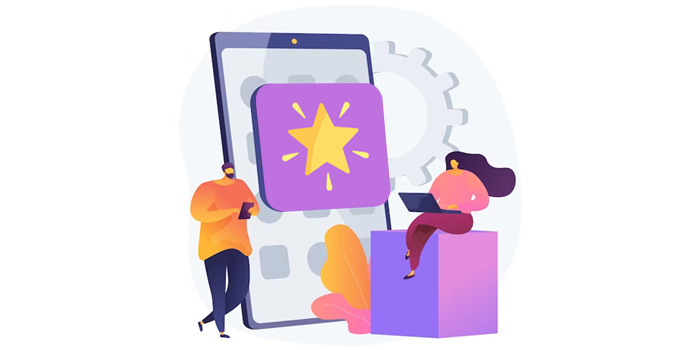
You can offer things like study plans, games, and free trials to get people interested. Use study data to convince people who don’t believe you. Give progress monitors and personal stats to get people involved and motivated. Add different functions to your meditation app to make it interesting and valuable.
5th Step: Use The MVP (Minimum Viable Product)
MVP needs to have the basics, like a way to join in, an introduction, a few meditations, a picture of a user profile, and unique features. One way to market the app is to present it to potential sponsors and organize a focus group to evaluate its effectiveness.
A straightforward, step-by-step process can help you duplicate the Headspace app successfully.
6th Step: Make The Finished App And Put It On The Market
You can perform development by a team inside or outside the company. Ensure your team members know how to make apps for the Health & Wellness market. Ensure your marketing team is ready to push the app when it comes out.
You can also get help from the top mobile app design firm that is Creatix9 US, if you need skilled Android or iOS developers, coders, and testers. We’ll be ready to hire more people for you in a few weeks.
Conclusion
When making a meditation app, you should outsource and hire strong experts to ensure you have the right skills.
As a top cross-device development and react mobile app design company, we look at your business idea, give you budget and time estimates for your meditation app, and put you in touch with our matchless Android or iOS developer. Contact us now.


